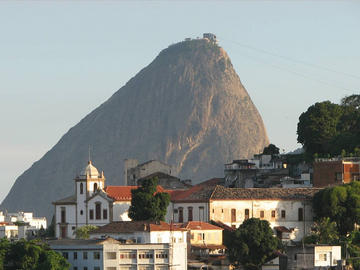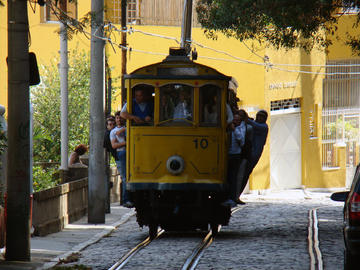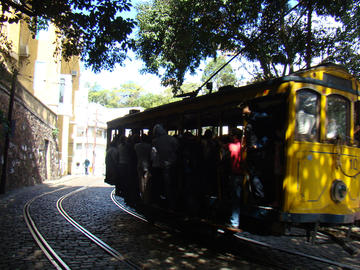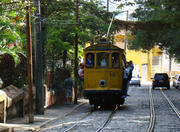Picture
More information on Santa Teresa Neighborhood in Rio de Janeiro

Description: Santa Teresa Neighborhood in Rio de Janeiro
The neighborhood of Santa Teresa was born outside of a convent on Morro do Desterro, Rio de Janeiro in the early 18th century. The district occupies a hilltop in the heart of the city and seems to have stopped in time, keeping dozens of years preserved features of Old Rio and a story around every corner.
Writers and artists have always been attracted to Santa Teresa, seduced by its charm and its architectural and cultural treasures, visible to the eyes and heart. The art displayed in the many workshops that took over the neighborhood, finds its stronghold in Santa, how they prefer to call them passionately. Everything that exists and knows about Santa Teresa is also a bit of history in Rio But it seems to the visitor a place apart with their own characteristics.
The narrow winding streets through which the old trams, the only ones that still circulate in Brazil, are more a singular attraction. The charming vehicles circulating in the last century, propelled by animal and later by electricity. Remnants of a romantic era, were listed as historic site and still go perfectly preserved tracks taking visitors to a rereading of the past.
The tram leaves the city center, passing over the Arcos da Lapa and follows the route of the time in up-and-down from the hills of Santa Teresa. The starting point is the station in Largo da Carioca, the station is very near the headquarters of Petrobras, Rua Lelio Gama. The place has a lovely garden and reveals a little of what you'll find this ride.
With less than $ 1 to purchase a ticket to ride the famous tram flower. There are two lines that travel in Santa Teresa, Paula Matos and called Two Brothers, with intervals of 30 minutes of departure.
The Church and Convent of Santa Teresa, responsible for the name of the district, belonging to the Order of Discalced Carmelite, religious houses that are isolated and have little contact with the outside world. The order preaches simplicity, humility and discretion. Few residents have seen the nuns in the neighborhood.
Largo Curvelo
The tram arrives at Admiral Street Alexandria, the oldest in the district. It is the House Vessel, inspired on the deck of a vessel, pure architectural daring. And that's the same street that has the surprising Valentine Castle, a fortress built in neo-romantic style. Built in the late 19th century, was the residence of Commander Anthony Valentine, designed by his son. Today the building serves as an apartment building. That way, a belvedere beautiful Guanabara Bay.
Largo do Guimarães and Largo das Neves
The streetcar into the heart of the neighborhood. Now just enjoy and live the bohemian Santa Teresa typical. Largo do Guimarães concentrate the hottest restaurants and bars, offering cold beer and great snacks. Among them, Bar do Mineiro, Bar Arnaudo (food Northeastern), Supernatural (seafood) and Adega do Pimenta (German). When night falls, the agitation takes place. Artists and intellectuals roam everywhere, with lots of pretty and popular Brazilian music. Following the tracks of the tram takes you to Largo das Neves, where is a beautiful hamlet of 1850 and the Church of Our Lady of the Snows, in 1860, plus a series of very popular bars. The location is the end point of driving and there is worth tasting the broth Goyabeira Green Bar, Café sandwiches or pastries of Snow's shrimp Santa Saideira.
Ruins Park
The Ruins Park becomes a wonderful viewpoint that leaves the Rio de Janeiro at his feet. From there, it has an extraordinary view of downtown and the whole edge of the River - from the Santos Dumont Airport to Urca. Just below are the Arcos da Lapa. Open to the public, the park is what remains of the Palace Murtinho Noble, where he lived Laurinda Santos Lobo. The house was one of the most exciting cultural life in Rio for many years until the death of the host in 1946. The City Council has resurrected from the ruins the culture that existed there. The park houses an exhibition hall, auditorium and cafeteria for the comfort of music concerts, happy hours and reading of literary texts. In the outdoor areas are popular shows and special programming for children on weekends. With three floors, the house draws attention for its architecture and style - brick harmoniously combined with metal and glass structures.
Centro Cultural Laurinda Santos Lobo
In a beautiful house in the neighborhood, opened in 1979 this cultural center that pays homage to Laurinda Santos Lobo. Laurinda was a special woman who earlier this century, virtually commanded the intellectual life of the river, promoting evenings and giving life and grace in Santa Teresa. The photographic collection shows Laurinda into action and takes the visitor to the Santa Teresa Times of Laurinda Santos Lobo. The center also has video rooms and exhibition spaces.
Museum House of Benjamin Constant
The tram goes through a beautiful country house where he lived Benjamin Constant, leader of the Republican movement. His house has been transformed into a museum, completely restored with furniture, books, objects, photographs and art collections. The area surrounding the museum is totally wooded and ideal for a quick rest until the next stop. Do not confuse the Museum with the Institute Benjamin Constant, who works in Urca. In the latter, the name of Benjamin appears because it was he who founded and directed for many years the Institute of the Blind Boys.
Chacara do Ceu Museum
Raymundo Castro Maya was a successful businessman, who dedicated himself to the city's cultural life as a collector and patron. It's the hook for more than a quarter of the farm, inherited by Castro Maya in 1936. The building, designed in 1957 by modernist architect Wladimir Alves de Souza. There, now runs the Finca Museum of Heaven, which, to the delight of the visitor, has a collection of important works of modern art, with highlights such as by Portinari, Di Cavalcanti, Guinard, Picasso, Matisse and Dali. In paintings, watercolors and engravings, Brazil 19th century is shown by travelers as Debret and Taunay.
Address: Tram station - next to the Carioca Aqueduct, at Rua Lelio Gama.
http://www.rio.rj.gov.br/web/riotur/exibeconteudo?article-id=157387
More Photos of Picture




